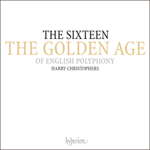O Wilhelme, pastor bone is one of Taverner’s more forward-looking and immediately attractive compositions, written in an uncomplicated note-against-note style, with largely syllabic text setting and systematic alternation of choral groupings. There are only two surviving sources, dating from the 1540s and the 1580s, both of which give the first line as ‘Christe Jesu, pastor bone’. Nevertheless, it is now thought that the text was originally addressed to St William, twelfth-century Archbishop of York, and that the second verse included a prayer for Cardinal Wolsey. The statutes of Cardinal College required that antiphons to St Mary, the Holy Trinity, and St William be sung daily after Compline. Wolsey was Archbishop of York, and the tercentenary of his predecessor’s canonisation fell a few months after Taverner’s appointment to the College, so that it is quite likely that a special setting of St William’s antiphon should be written for celebrations of that event. It would have been a simple matter, after the re-founding of the College, to adapt the text so that it became a Jesus antiphon with a prayer for the king in the second verse; in the 1580s it was altered once again into a prayer for Queen Elizabeth.
from notes by John Heighway © 2000
O Wilhelme, pastor bone est une des compositions de Taverner qui est le plus immédiatement attrayante et progressive, écrite dans un style simple de note-sur-note, avec une mise en musique de texte largement syllabique et une alternance systématique de groupes choraux. Deux sources seulement ont survécu, qui datent des années 1540 et des années 1580, et toutes deux donnent le premier vers comme: «Christe Jesu, pastor bone». Cependant, l’on pense maintenant que le texte était à l’origine adress‚ à Saint William, archevêque de York au douzième siècle et que la seconde strophe comprenait une prière adressée au Cardinal Wolsey. Les statuts du Cardinal College exigeaient que les antiennes à Sainte Marie, à La Sainte Trinité et à Saint William soient chantées tous les jours après Complies. Wolsey était archevêque de York et le tri-centenaire de la canonisation de son prédécesseur tombait quelques mois après la nomination de Taverner au Collège, de sorte qu’il est tout à fait vraisemblable qu’un arrangement spécial de l’antienne à Saint William fût composé pour célébrer l’événement. Après la re-fondation du Collège, cela n’aura été qu’une simple procédure d’adapter le texte pour qu’il devienne une antienne à Jésus Christ avec une prière pour le roi dans la seconde strophe; dans les années 1580, celle-ci fut changée une fois encore en une prière pour la Reine Elisabeth.
extrait des notes rédigées par John Heighway © 2000
Français: Hypérion
O Wilhelm, pastor bone ist eine der zukunftsweiserenderen und unmittelbar eingängigeren Kompositionen Taverners, geschrieben in unkompliziertem Stil gleichwertiger Noten, mit hauptsächlich syllabischer Vertonung des Textes und systematischem Wechsel zwischen den Chorgruppen. Sie ist in zwei Quellen aus den 40er und 80er Jahren des 16. Jahrhunderts erhalten, die beide die erste Zeile mit „Christe Jesu, pastor bone“ angeben. Dennoch wird heute angenommen, dass sich der Text ursprünglich auf den heiligen Wilhelm bezog, einen Erzbischof von York im 12. Jahrhundert, und dass der zweite Vers ein Gebet für Kardinal Wolsey enthielt. Die Statuten des Cardinal College sahen vor, dass täglich im Anschluss an das Abendgebet Antiphone auf die heilige Maria, die Heilige Dreifaltigkeit und den Heiligen Wilhelm gesungen wurden. Wolsey war ebenfalls Erzbischof von York, und die Dreihundertjahrfeier der Heiligsprechung seines Vorgängers erfolgte wenige Monate nach Taverners Berufung an das College. Darum ist es recht wahrscheinlich, dass zur Begehung dieses Ereignisses eine besondere Vertonung des Antiphons auf den Heiligen Wilhelm geschrieben wurde. Es wäre ein leichtes gewesen, nach der Neugründung des College den Text so zu bearbeiten, dass daraus ein Jesus-Antiphon mit einem Gebet für den König im zweiten Vers wurde; im weiteren Verlauf der 80er Jahre des 16. Jahrhunderts wurde er noch einmal umgeändert in ein Gebet für Königin Elizabeth.
aus dem Begleittext von John Heighway © 2000
Deutsch: Anne Steeb/Bernd Müller


 The Sixteen & The Golden Age of English Polyphony
The Sixteen & The Golden Age of English Polyphony
